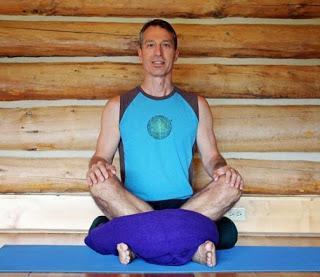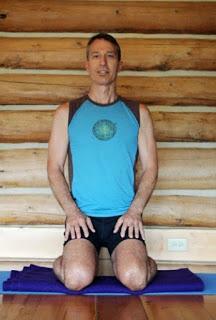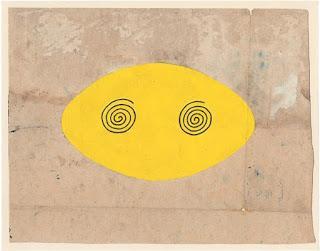From Tantra Song by Jamme
I can’t even remember the first time I meditated—or who taught me to do it—though it was probably my very first yoga teacher back in the 80s. Because I’m pretty sure we just sat in a simple Seated Crossed Legs position on the floor and focused on our breath. Like it was no big deal. So, in a way, basic meditation is very simple. Sometimes a teacher will even just say, “Let’s sit for a few minutes.”But those basic techniques don’t work for everyone. First of all, not everyone can be comfortable sitting on the floor without support or even with support. And being in pain while you are sitting—or sitting in such a way that you might injure yourself because you are slumping or overstretching—is not conducive to regular, long-term practice. So it’s important for there to be different options for the meditation position you use. Second, not everyone is comfortable using his breath as the object of meditation. I have a student who instantly becomes anxious when he focuses on his breath. So he definitely needs to meditate on something else. And the rest of us will no doubt having breathing problems eventually, whether from a cold or allergy, so it’s good to have an alternative up your sleeve.So I thought that today I’d write a bit about the options you have when you are meditating. And because the position you take and the object of meditation you choose will be influenced by the environment in which you’re practicing, let’s start by talking about location. I’ll then address position, mental focus, timing, and meditating.
Choose Your LocationYou probably have an image of the perfect quiet, warm, clean environment in which you should meditate, but real life doesn’t always present that. If you can’t set up a separate space because you live in a small apartment or crowded family house, you shouldn’t let that stop you from practicing. As long as there is room for you to sit—whether on the floor or even on a chair—you can meditate.So by all means, if you can set up a separate quiet space for your meditating practice, do that. But if not, just do the best you can. And when you’re traveling or are stuck somewhere busy and noisy, such as at an airport or even on an airplane (yes, I’ve done that), go ahead and practice there, too. It’s more challenging to practice when there are distractions or you are in a public place, but it is still practicing, and in fact it’s probably a more realistic way of learning to quiet your mind.You might even choose to meditate somewhere challenging just for the experience of it. If you haven’t read Achieving Stillness in Turbulent Situations, I strongly recommend that you do. I, for one, was forever changed when I read that Ram’s grandfather took him to an Indian train station to meditate just to teach him to experience meditating in the most challenging environment possible. As Ram said:"The goal of meditation is to be at ease, relaxed and at peace with our surroundings. It is important to not resist the disturbing/distracting influence that comes in the way of your meditation practice (in your case traffic or the cold environment). So do not try to ignore the influence or to block it out, for if you try, you will only meet with stiffer resistance, ending in frustration. Instead, simply let it be (“thathaasthu” in Sanskrit) and continue with your meditation. Everything is a part of meditation, all the influences including the noise, the thoughts, the emotions, and the resistance from the mind. Treat everything that arises in meditation the same way—let it be and just be there!"
Choose Your PositionTypically people meditate in a seated position on the floor. That’s simply because an upright, unsupported position allows you quiet your mind without falling asleep. For those who can’t sit for long periods of time without major discomfort, reclining is also an option if you’re in the right environment. And, finally, for short meditations, you can even meditate standing up. Obviously your environment affects your position choice, as sometimes your options are limited.Seated Positions. Our recommended positions for seated meditation are Seated Crossed Legs and Hero pose (although a few people are comfortable enough in Half Lotus or even Full Lotus to meditate in those poses). In his post Learning to Sit on the Floor, Baxter described how you can use props to get comfortable in these poses.

Seated Crossed Legs Pose

Hero Pose
For people who just can’t get comfortable on the floor—or who can’t get up and down from the floor—sitting on a chair is always an option. But rather than leaning against the back of the chair and slumping, sit on the front edge of the chair with your feet flat on the floor (if you are short, you might need to put a prop under them or if your legs are long you might need to put some padding on the chair seat) and your spine in its natural curves and your head in line with your spine. Obviously someone with physical disabilities who is in a wheelchair can meditate in whatever position they are able to take, in whatever chair they happen to be.Reclining Positions. In his post Starting a Meditation Practice, Timothy said, “Although it may not be ideal, for those who can't sit comfortably, it is possible to meditate lying down. Yes, there is a greater tendency to get sleepy or zone out while supine, but we should not let the perfect be the enemy of the good.” And Baxter invites students with body pain that makes it very difficult for them to keep their meditation focus to lay in supported Savasana.
So if you really can’t get comfortable sitting down (or maybe you sit down all day for your work and just can’t take it any longer), try a supine position. Because you want to avoid falling asleep, I feel that the best recelining position to meditate in would be a supported form of Savasana where your head and heart are higher than your legs (as opposed to being flat on the floor or having your legs higher than your heart). This will keep you a tiny bit stimulated and might help prevent you from falling asleep.


Different yogic traditions have different focuses and techniques for meditation. So if you are already practicing mediation or following a certain tradition, you can simply continue using whatever technique you’ve been taught. However, if you are new to meditation or want to change things up, here are some suggestions:
Breath. The breath is often recommended for beginners because it is always accessible and has no religious associations. You can focus on any aspect of your breath, including the sound of your breath, the feel of your breath moving in and out of your nostrils, or the way your inhalations and exhalations affect your body (such as the rise and fall of your belly or the movement of your breast bone). For beginners, Timothy recommends the So Ham technique (see Starting a Meditation Practice). But meditating on your breath doesn’t work some people, and if you’re ill or in pain, it be better for you to take your mind off your body.
Mantras. Although there are traditional Sanskirt mantras used for meditation, you can use any word or phrase in any language that has a positive meaning for you as a mantra. Baxter reports that he’s used both the word “Om” as well as his grandmother’s name, Genevieve!Images. There are two ways to use an image as your focus. First, you can open your your eyes and focus on an actual image before you, such as a candle flame or an artwork. The following image, as is the one at the beginning of the post, is from a beautiful book called Tantra Song that contains a collection of amazing 17th Century Tantric images from Rajasthan designed for meditating on,. My purpose in sharing these is to emphasize that your stereotypes of what an object of meditation should be may be limiting your alternatives.

If you’re just starting a meditation practice, don’t get caught up in how long to do a practice. The important thing is to start a new habit. As with all yoga practices, a little bit every day will bring greater benefits than longer sessions done intermittently. Baxter recommends keeping it simple and doable, with just 5 or 10 minutes at first. Timothy even says he’d recommend trying to stay for 3-5 minutes initially. Set a timer of some sort so you don’t have to have thoughts about worrying how long you’ve been meditating. As your habit becomes established, you can gradually work up to 20 minutes or longer daily.
How to MeditateAfter you have chosen your location, position, and mental focus, and have set your timer, simply:
- Commit to remaining still.
- Focus on your chosen object of meditation. When you realize your mind is wandering (and it will wander), notice the thoughts you were having and then, without judgment, gently guide your focus back to the object. In yogic meditation you are not trying to make your mind empty, but instead are learning how to concentrate your focus (see Samyama: The Trinity of Dharana, Dhyana, and Samadhi). With sustained attention, you may slip into a meditative state. But because our minds tend to wander—even for experienced meditators—there may not be much (or even any) actual meditation in any particular session.
- Stop when your timer goes off. After your practice session, refrain from judging how well it went. Instead, simply continue with your day.
"My mind was very busy when I began, and it was extremely difficult for me to keep my attention from flitting from idea to idea. And it was hard to find comfort sitting in one place, without frequent position adjustments and fidgeting. Many people who try to meditate get discouraged at this point and give up. That, I believe, is a mistake. As with a lot of other areas of yoga, hanging in when things are challenging, even discouraging, can bring rewards."
Now he says that meditation is the most delicious part of his practice. In the meantime, consider that Dr. Herbert Benson’s studies of the Relaxation Response, which he performed on people practicing mantra meditation, showed that even when practitioners didn’t feel they aren’t doing a “good job” of meditating, they still gained the physiological benefits of lower blood pressure, slower heart rate, fewer stress hormones, and so on. (see The Relaxation Response and Yoga).
Other Posts About Meditation
Friday Q&A: What is Meditation? by Baxter
Samyama: The Trinity of Dharana, Dhyana, and Samadhi by Ram
Achieving Stillness in Turbulent Situations by Ram
Is Meditation an Essential Part of Practicing Yoga? by Timothy
Starting a Meditation Practice by Timothy
Subscribe to Yoga for Healthy Aging by Email ° Follow Yoga for Healthy Aging on Facebook ° Join this site with Google Friend Connect


